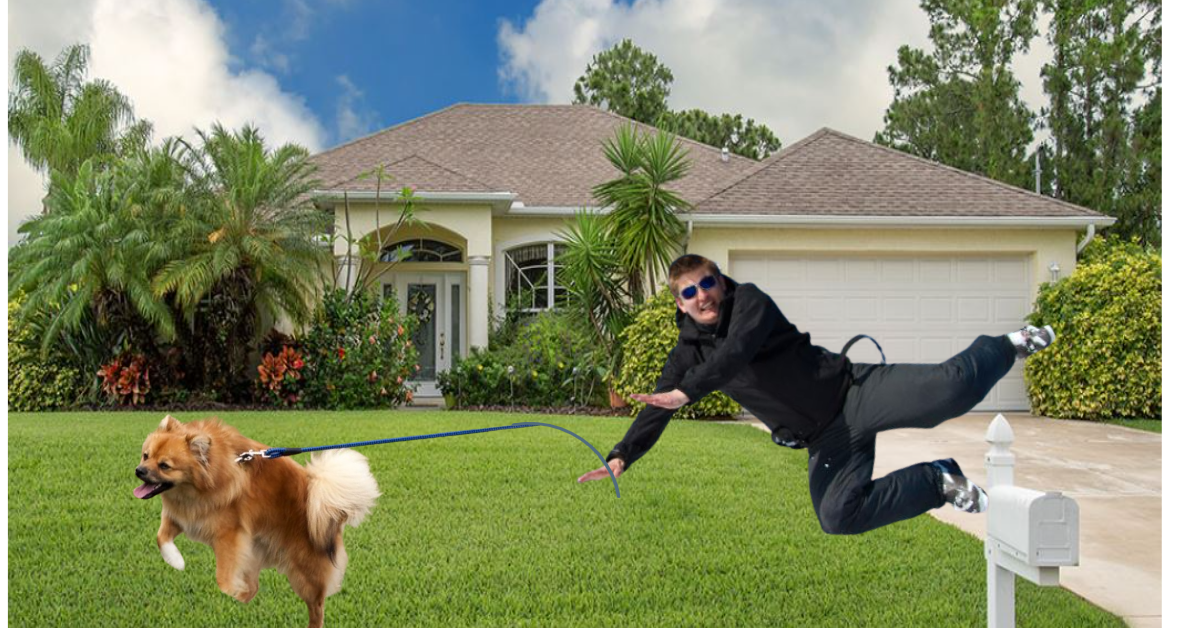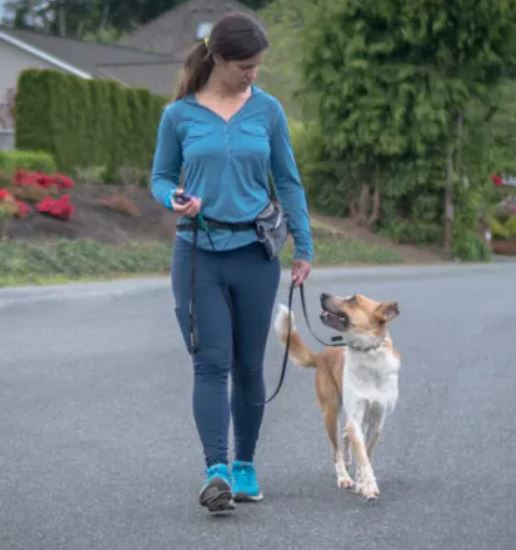The dogs pulling on leash post may contain affiliate links. Learn more on my Affiliate Disclosure page.
The dangers and effects of dogs pulling on leash can be more than just frustrating and physically harmful to you and your four-legged friend.
Are you tired of being dragged down the street by your over-enthusiastic canine companion? Do you dread taking your furry friend for a walk because they transform into a force to be reckoned with when the leash is attached? If so, you are not alone. But fear not!
In this article, we will delve into why dogs pull on leash, explore the potential consequences, and, most importantly, provide practical strategies to end this behavior.
The Problem with Dogs Pulling on Leash
One of the biggest problems dog owners face is the constant pulling on leash. It can turn a peaceful walk into a battle of strength and frustration. But have you ever stopped to think why dogs pull in the first place?
One reason could be that they are excited and eager to explore their surroundings. Dogs have an innate curiosity and desire to sniff, mark territory, and investigate new scents.
Holding them back with a tight leash creates a natural tension that dogs try to pull even harder.
Another factor contributing to this issue is the need for obedience and socialization training. Many dog owners must teach their furry friends how to behave correctly on a leash from puppyhood.
Appropriate training on how to stop dogs from pulling on leash will help them develop good habits and never pull or lung toward people or other animals in an attempt to interact with them.
How to stop dogs pulling on leash training prevents the intimidation of pedestrians and other dog owners, leading to tense situations during walks.
To address this problem effectively, we, as dog owners, must understand our canine companions' needs and work on training them accordingly.

Providing mental stimulation through activities like puzzle toys or scent games will help satisfy their curiosity, reducing their need to pull on their leash constantly.
Dogs Pulling On Leash The Potential Consequences
Dogs pulling on leash can have various potential consequences, both for the dog and the owner.
Firstly, it can cause physical harm to the dog.
Constant tugging on the collar or harness can cause neck strain, including shoulder issues, leading to injury over time.
It may also impact their ability to breathe properly, causing discomfort and respiratory issues.
Beyond the physical consequences, dogs constantly pulling on leashes can also develop behavioral problems. Results include increased aggression towards other dogs or people while on walks and difficulty following commands or maintaining focus during training sessions.
The consequences of dogs pulling on leash are not limited to just the dog; owners also experience various challenges due to this behavior.
Pulling makes walks less enjoyable and more exhausting for owners who constantly struggle against their dog's strength. It decreases their control over the situation and may even discourage them from taking their furry friend out for much-needed exercise.
Additionally, excessive pulling can strain the bond between owner and dog, making establishing trust and cooperation in other training areas harder.
Understanding these potential consequences is crucial in recognizing why stopping dogs from pulling on leash is essential.
By addressing this issue, owners can ensure both the physical well-being of their canine companion and enhance their mutual enjoyment during daily walks while building a stronger human-dog relationship based on respect and harmony.
Understanding the Reasons Behind Dogs Pulling On Leash Behavior
To effectively stop a dog from pulling on leash, it is crucial to understand the reasons behind this behavior.
One common explanation is that dogs are naturally curious and eager to explore their environment. When they encounter new scents, sights, or sounds, their instinct drives them to move forward, often with great enthusiasm.
Another reason could be a need for proper training and socialization. Dogs not exposed to different situations and environments may become overwhelmed by the stimulation outside their comfort zone, causing them to pull in an attempt to regain control.
Furthermore, some dogs pull on leash due to biological factors or genetic predispositions. Certain breeds are more prone to pulling due to their natural traits, such as high energy levels or strong prey drive.
Lastly, dogs can also develop pulling behavior as a learned response if rewarded for pulling in the past.
For example, if a dog has reached something rewarding (like greeting another dog) by lunging forward while on a leash, they may associate this action with getting what they want and continue doing so.
By understanding these underlying reasons for dogs' pulling behavior on a leash, we can better address it with appropriate training techniques tailored to each dog's needs and personality.
Managing Dogs Pulling On Leash Behavior
Stopping dogs from pulling on leash behavior is essential for their safety and sanity during walks.
One approach to address this issue is through positive reinforcement training. Rather than punishing your dog for pulling, focus on rewarding them when they walk calmly by your side.
A reward can be given by offering treats or verbal praise whenever they stay close to you and avoid pulling. By consistently reinforcing this desired behavior, you can gradually teach your dog that walking without pulling is more rewarding than the alternative.
Another method to manage leash pulling is using proper equipment. Consider using a front-clip harness that attaches to the leash rather than a back-clip harness.
A front-clip harness helps redirect your dog's forward momentum when your dog attempts to pull, making it harder for them to continue doing so effectively.
Likewise, a head halter or gentle leader training collar can also be an effective tool in discouraging pulling, giving you greater control over your head movements.
Remember that consistency is critical when dealing with leash-pulling behaviors in dogs. It may take time and patience, but with consistent positive reinforcement and appropriate equipment, you can help teach your furry friend to walk calmly on a leash without constantly tugging at it.
Ultimately, understanding why dogs pull on leashes and utilizing effective strategies will lead you towards enjoyable walks together in no time! Training Techniques for how to stop dogs pulling on leash
Consistency and Patience
Consistency and patience are key ingredients in successful dog training, especially when stopping dogs from pulling on the leash.
You must understand our furry friends are creatures of habit, so if you want to help them break destructive behaviors, it will take some time and effort!
By consistently reinforcing desired behaviors and patiently working through challenges, you can make significant progress in teaching your furry friend how to walk nicely on a leash.
Consistency means being firm yet fair with your dog. Set clear rules and boundaries from the start, and stick to them.
Please ensure everyone in the family is on the same page regarding how to stop dogs pulling on leash training methods and expectations. This consistency will help your dog learn good behavior quickly while walking on a leash.
Patience is equally crucial in this process. Understand that learning new behaviors takes time for both you and your pup.
Dogs need help understanding what we want from them, so be patient as you guide them through the process. Celebrate small wins, such as when your dog walks beside you without pulling or listens when you ask for their attention.
Equipment and Tools Designed To Stop Pulling
One effective way to curb your dog's pulling behavior on a leash is by utilizing equipment and tools specifically designed for this purpose.
Traditional harnesses often exacerbate the problem, giving dogs more leverage to pull. Instead, consider front-clip harnesses are a popular choice for trainers, as they help keep the pup from pulling on the leash.
The chest clip gives the owner the power to decide which way your puppy goes and makes it easy to get their attention and redirect them if need be. The front-clip harness helps discourage pulling and gives you better control over your dog's movements.
Another helpful tool to assist with leash training is a no-pull head halter. Similar in design to horse halters, these devices fit around the back of your dog's head and snout, allowing you to guide their attention without force.
The gentle pressure exerted by the halter redirects their focus toward you while discouraging any pulling tendencies. However, it is essential to introduce the head halter gradually and adequately train your dog on its use before relying solely on this tool.
Lastly, there are also specialized leashes available that can aid in preventing excessive pulling.
These leashes typically have two handles: one at the end for regular walking and another closer to the clip for added control. Having the second handle gives you extra leverage and grip when your dog starts tugging or lunging forward unexpectedly.
By utilizing these equipment options with consistent training techniques and positive reinforcement methods, you will be well on your way to enjoying peaceful walks with your furry friend without any unnecessary pulling or strain on both of you!
Stop the pulling and start enjoying peaceful walks with your dog! - The PetSafe Easy Walk No-Pull Dog Harness is designed to gently discourage dogs from pulling on their leash, making walks a breeze for you and your furry friend. Say goodbye to arm strain and hello to more enjoyable strolls in no time!
No More Pulling: Dual Leash Clips for Versatility: With two sturdy metal leash clips on the back and front of the harness, you can choose the most suitable attachment point for your dog's behavior and training needs. The no-pull design distributes the pressure evenly across the chest, discouraging pulling behavior without causing discomfort.
Loose Leash Training
After you have mastered how to stop dogs from pulling on leash, it is time to teach the loose leash training technique.
Loose leash training is an essential skill that every dog owner should master.
While it may seem challenging initially, with patience and consistency, you can teach your furry companion to walk politely by your side without constantly pulling on the leash.

One of the keys to successful loose leash training is creating a positive association between walking calmly and receiving rewards. You can teach your dog that staying close to you is beneficial by using treats, toys, or verbal praise as reinforcements.
Another effective technique in loose leash training is incorporating frequent stops during walks. When dogs pull on the leash, stop walking and wait for them to return to your side before continuing.
Not only does stopping remind them that pulling won't get them what they want (forward movement), but it also reinforces the idea of walking together as a team.
In time, with consistent practice and plenty of rewards, your dog will begin to understand that a loose leash means more enjoyable walks for both of you.
Remember, loose-leash training requires time and effort from both you and your furry friend.
Stay patient and remain consistent in implementing these techniques throughout each walk.
Celebrate even small improvements, and remember there will likely be setbacks, which is all part of the learning process!
With dedication and a positive mindset, you and your dog will soon discover the joy of walking on a loose leash.
Check the American Kennel Club for its article "How to Stop Leash Tugging and Biting When Walking."
K9 Training Institute Dogs Pulling On Leash Training
Does your dog pull hard on its leash, preventing the enjoyment of a stroll together? But fear not because the K9 Training Institute can help you regain control and make your walks enjoyable again.
The specialized dogs pulling on leash training program addresses this common behavior issue and provides practical strategies for ending the constant tugging.
One of the critical aspects of the training program focuses on teaching dogs that pulling will not get them where they want to go. Through positive reinforcement techniques, special training teaches a dog to walk politely by its owner's side.
The dog earns rewards, which allows for a smoother, more relaxed walk—consistently rewarding desired behaviors and redirecting attention away from distractions. Dogs learn to enjoy walking on a leash without pulling.
Another essential element in addressing leash-pulling is ensuring that your dog's physical exercise needs are met outside of walks.
Dogs often pull because they have pent-up energy and need an outlet. Incorporating activities such as fetch or agility training into your routine can tire them out before going on a walk and make them less likely to pull excessively.
The K9 Training Institute staff understands how frustrating it can be when your dog constantly pulls on a leash while you're out trying to enjoy some quality time together.
The K9 comprehensive dogs pulling on leash training program aims to equip you and your canine companion with the tools for successful leash manners.
Check out the video on this page for more information.
Does your dog tug on its leash, bark constantly, and won't come when called? Sign Up and get the FREE Obedience Training Workshop Now!
Conclusion: Enjoying Stress-Free Walks with Your Dog
In conclusion, mastering the art of stopping dogs from pulling on leash has practical benefits and creates an enjoyable experience for you and your furry companion.
You can transform your dog's behavior and make walks a stress-free adventure by implementing simple techniques such as consistent training, positive reinforcement, and using the right equipment.
One critical insight to remember is that staying patient and consistent is paramount.
Dogs are creatures of habit, so it's essential to maintain a routine in your training efforts. A routine will help reinforce good behavior over time and prevent any setbacks.
Remember to reward your dog's positive actions with treats or praise. Positive reinforcement encourages your dog to continue behaving well on walks.
Finally, consider investing in the right equipment for your dog's needs. A properly fitted harness or leash can significantly assist you in managing pulling behaviors. Take the time to find gear that suits you and your furry friend comfortably while ensuring control during walks.
Following these strategies and emphasizing positivity throughout training, you'll soon enjoy peaceful strolls with your four-legged companion – free from tugging battles or unnecessary stress.
Remember that each walk is an opportunity for bonding with your dog while exploring the world together. So take a deep breath, put on that smile, and embark on stress-free adventures that you and Fido will cherish forever!

More Related Dog Training Articles:






